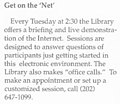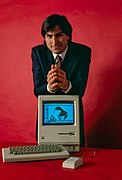
Back بوابة:إنترنت Arabic دەروازە:ئینتەرنێت CKB Portál:Internet Czech Portal:Internet German Portal:Internet Spanish درگاه:اینترنت Persian Portail:Internet French פורטל:אינטרנט HE Պորտալ:Համացանց Armenian Portal:Internet ID
The Internet PortalThe Internet (or internet) is the global system of interconnected computer networks that uses the Internet protocol suite (TCP/IP) to communicate between networks and devices. It is a network of networks that consists of private, public, academic, business, and government networks of local to global scope, linked by a broad array of electronic, wireless, and optical networking technologies. The Internet carries a vast range of information resources and services, such as the interlinked hypertext documents and applications of the World Wide Web (WWW), electronic mail, telephony, and file sharing. The origins of the Internet date back to research that enabled the time-sharing of computer resources and the development of packet switching in the 1960s. The set of rules (communication protocols) to enable internetworking on the Internet arose from research and development commissioned in the 1970s by the Defense Advanced Research Projects Agency (DARPA) of the United States Department of Defense in collaboration with universities and researchers across the United States and in the United Kingdom and France. The ARPANET initially served as a backbone for the interconnection of regional academic and military networks in the United States to enable resource sharing. The funding of the National Science Foundation Network as a new backbone in the 1980s, as well as private funding for other commercial extensions, encouraged worldwide participation in the development of new networking technologies and the merger of many networks using DARPA's Internet protocol suite. The linking of commercial networks and enterprises by the early 1990s, as well as the advent of the World Wide Web, marked the beginning of the transition to the modern Internet, and generated sustained exponential growth as generations of institutional, personal, and mobile computers were connected to the network. Although the Internet was widely used by academia in the 1980s, the subsequent commercialization in the 1990s and beyond incorporated its services and technologies into virtually every aspect of modern life. (Full article...) Selected article The city of Minneapolis, Minnesota, is covered by a citywide broadband wireless internet network, sometimes called Wireless Minneapolis. The network was first proposed in 2003, at which point only a few other cities nationwide had such systems in place. Local firm US Internet beat out EarthLink to build and operate the network, with a guaranteed ten-year, multimillion-dollar contract from the city itself as the network's anchor tenant. Construction began on the project in 2006, but encountered several delays. Most of the city was covered by the network by 2010, and USI Wireless, the subsidiary of US Internet responsible for the system, set up numerous free internet access points at public locations around Minneapolis. The network, which offers speeds of one to six megabits per second at a rate of about $20 per month, had about 20,000 residential subscribers by the end of 2010. Municipally, the network is used by city inspectors and employees, with plans in place for the police and fire departments to use it in the future. In 2007, when the I-35W Mississippi River bridge collapsed, the wireless system helped coordinate rescuers and emergency services. The city and USI Wireless have won praise for the network, which has been singled out for being one of the few successful municipal wireless ventures nationwide among a number of stalled or failed projects. (Full article...) Selected picture Wardriving is the act of searching for Wi-Fi wireless networks by a person in a moving vehicle using a Wi-Fi-equipped computer, such as a laptop or a PDA. It is similar to using a radio scanner, or to the amateur radio practice of DXing. News
Wikinews Internet portal
WikiProjects
Did you know (auto-generated) -
Selected biography
Marc Andreessen (born July 9, 1971, in Cedar Falls, Iowa and raised in New Lisbon, Wisconsin, United States) is a software engineer and entrepreneur best known as co-author of Mosaic, the first widely-used web browser, and co-founder of Netscape Communications Corporation. He was the chair of Opsware, a software company he founded originally as Loudcloud, when it was acquired by Hewlett-Packard. Netscape's success attracted the attention of Microsoft, which recognized the web's potential and wanted to put itself at the forefront of the rising Internet revolution. Microsoft licensed the Mosaic source code from Spyglass, Inc., an offshoot of the University of Illinois, and turned it into Internet Explorer. The resulting battle between the two companies became known as the Browser Wars. Andreessen is an investor in social news website Digg and serves on the board of Open Media Network. He is also a cofounder of Ning, a company which provides a platform for social-networking websites.
General images -The following are images from various internet-related articles on Wikipedia.
Selected quoteMore Did you know...
Main topics
Featured contentCategoriesRelated portalsThings you can do
Associated WikimediaThe following Wikimedia Foundation sister projects provide more on this subject:
Wikipedia's portals |
© MMXXIII Rich X Search. We shall prevail. All rights reserved. Rich X Search




















































